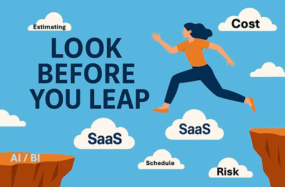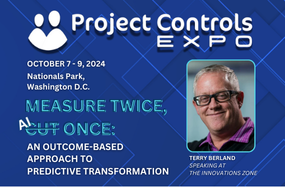
From Dashboard to Command Center: The New Power of the ‘Single Pane’

If you’re steering tech strategy, the concept of a “single pane of glass” is likely familiar —a unified interface designed to tame the chaos of data, applications and users essential to managing today’s complex projects.
But technology never stands still, and the single pane is no longer just about displaying data on one screen. The data-driven future of technology lies in tightly integrated applications that communicate with each other—surfacing patterns, triggering actions, and enabling smarter decisions. This isn’t just about reporting anymore. It’s about operational intelligence in motion.
Today’s Single Pane: A Living Command Center
What once functioned as a tactical dashboard is evolving into a strategic asset—one that synthesizes and displays data in real time and enables action. When powered by deep integration across applications, the single pane transforms into a living command center. And its impact extends far beyond IT.
Consider this example: a supply chain risk flagged in specialized SaaS tools connect seamlessly with resource plans, which tie directly into financial forecasts—all in one place. The result? True strategic control over risk, resource allocation, and project prioritization.
Even in its traditional form, the single pane delivered serious ROI—IDC found 50% efficiency gains for infrastructure teams using it for IT management. In our evolved version it transcends IT to become a true business critical tool that connects project, financial, and supply chain systems in real time, empowering proactive enterprise-wide decisions.
The Single Pane as a Catalyst for Adaptive Strategy
In capital project environments where change is constant, agility is everything. A modern single pane of glass empowers organizations to both see and respond to what’s happening nearly instantly.
When CIOs and CTOs embed this capability into their tech strategy, it becomes a lever for adaptability. Imagine reallocating resources from a delayed project to one gaining momentum, or proactively rerouting procurement before a disruption hits the schedule. This kind of responsiveness isn’t possible with siloed or delayed data.
With the right architecture and integrations, your single pane becomes a system of action—accelerating cross-project coordination and enabling real-time responsiveness across your organization.
The Backbone of the Single Pane: Architecture That Enables Action
The promise of a strategic single pane of glass doesn’t come from the UI—it comes from the architecture underneath. For CIOs and CTOs building this capability, the real challenge is integration at the data and application layer.
- First, it starts with normalized, trusted data. Disparate project management systems, ERP platforms, planning tools, and niche SaaS apps must feed into a unified data model. Without clean, contextualized data, the dashboard is just noise.
- Second, it requires an integration framework that supports real-time connectivity. Think APIs, data pipelines, and middleware that allow systems to talk to each other—securely and at speed. Point-to-point integrations won’t scale here; this is about building an architecture flexible enough to handle new tools, datasets, and workflows as they emerge.
- Finally, your single pane has to serve as more than a reporting layer. It needs to support workflow orchestration, alerts, and even AI-driven recommendations, so teams can not only see what’s happening but take immediate action—within the same platform.
The Role of AI and Automation
In our evolved single pane of glass, AI-driven insights and automated workflows can turn data into a self-optimizing system.
For example, AI can predict disruptions, analyze vast amounts of project data to identify hidden risks, and recommend solutions. When AI flags a potential procurement delay, it can automatically recommend adjustments to timelines, resource reassignments, and notify key stakeholders. This insight and automation enable teams to act before problems become crises.
This capability is key to driving smarter, faster decisions at scale.
As McKinsey outlines in their article “How Can Tech-Enablement Make Capital Projects Win Big?”, the third reason to adopt a single pane of glass is their ability to integrate both historical and predictive data, providing project leaders with real-time insights into performance. This enables them to solve problems and correct a project’s trajectory before it veers off course.
Why Cloud Is Non-Negotiable
None of this works without the cloud—a foundation that can support massive data volumes, distributed teams, and ever-evolving application ecosystems.
Cloud hosting enables the scalability, security, and speed required to unify tools across global projects. It allows real-time updates from job sites, remote collaboration between stakeholders, and fast deployment of new analytics or AI tools—without the overhead of traditional infrastructure.
For CIOs and CTOs, choosing the right cloud partner is a strategic decision. You need a platform that’s secure, compliant, and purpose-built for capital project complexity—with the agility to evolve with your digital ecosystem.
See why the capital projects industry trusts LoadSpring Cloud Platform
Use Case: How Integration Turns Risk into Response
Imagine a global infrastructure firm managing transportation megaprojects across North America and Europe. A steel supplier flags a delay through a procurement tool. Thanks to API-level integration, that alert feeds directly into the firm’s cloud-based single pane of glass.
The impact is visualized instantly. Affected schedules are flagged, resourcing conflicts surface through connected planning tools, and financial risks are highlighted—no manual effort, no waiting.
Within hours, teams reallocate float, reroute procurement to an approved vendor, and update forecasts for executive review. What could have triggered a multi-week disruption is resolved in a day.
From Visibility to Velocity
For today’s tech leaders, visibility is just the beginning. The true power lies in how data, tools, and teams converge in real time to highlight critical insights and prompt swift, informed action.
The single pane of glass is evolving—what was once a passive dashboard is now becoming an active command center, driving faster decisions, more agile responses, and smarter resource management. As capital projects grow in scale, complexity, and interconnectivity, embracing this shift isn’t just a smart move—it’s essential.
About LoadSpring
At LoadSpring, we specialize in helping tech leaders integrate cloud-based solutions that turn complex capital projects into strategic advantages. Let us help you modernize your approach with a unified platform that powers decision-making and drives operational efficiency.








